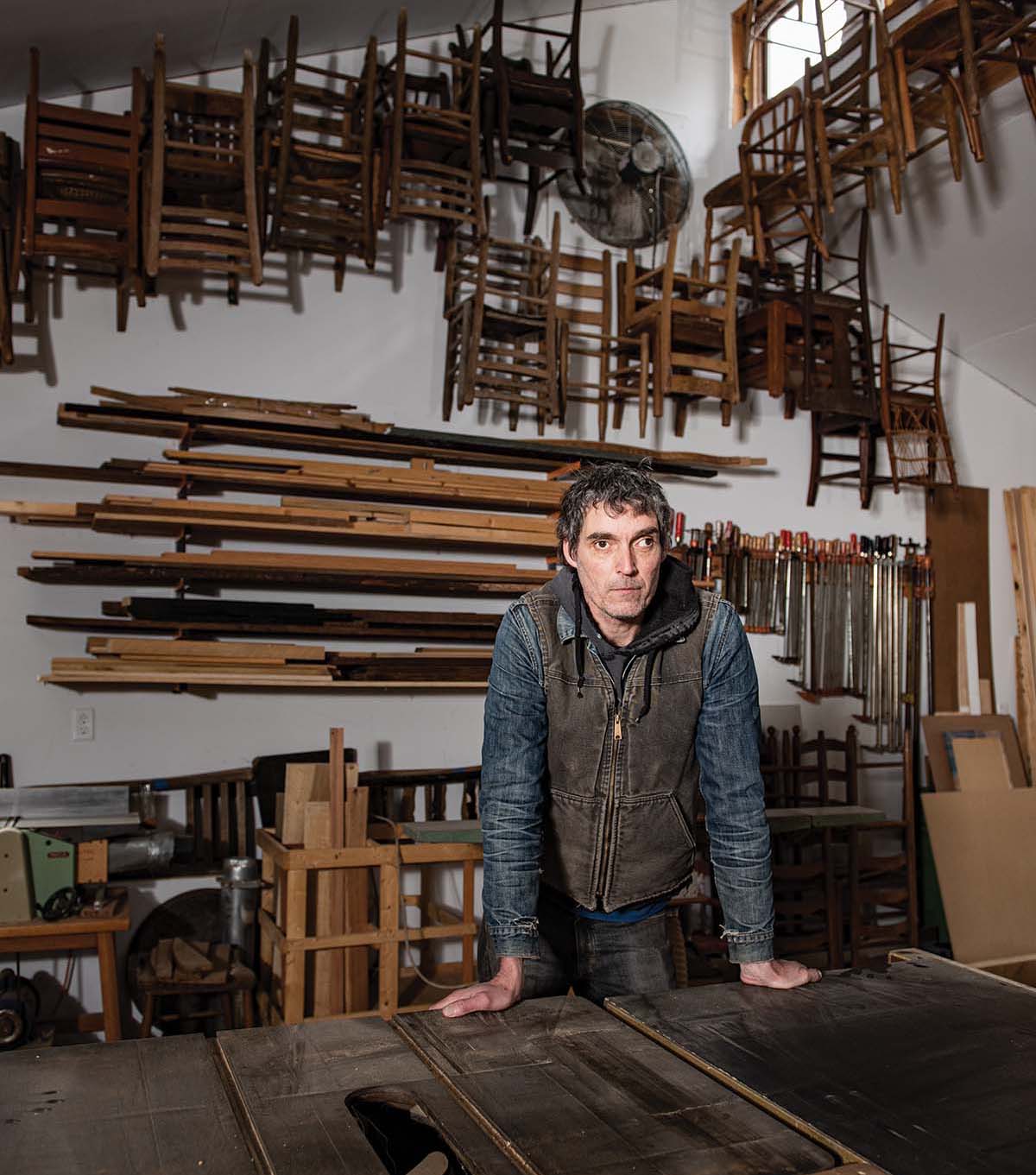
A chair may just be a chair to most of us, but to conceptual carpenter Tom Shields, a chair represents more than a utilitarian piece of furniture. “The chair is a perfect metaphor for a person,” Shields says. “Like us, it has arms, legs, a back, and a seat.” In that context, Shields’ imaginative sculptural pieces explore the nature of human relationships and the exploitation of the natural world for our own comfort.
“My work walks the line between furniture and sculpture,” Shields observes. “Two chairs back to back speak of a relationship in a certain way, while two seats overlapping address another idea.” Particularly evocative is a piece Shields calls “Divorce,” with adult-sized chairs nearly burying a foundation of children’s nursery chairs. Other of his pieces pile chairs on top of one another, or cluster them together with their backs entwined, or serve as mashups involving side tables or rough wooden pillars. “All of my chairs are sourced from trash,” Shields says, “which opens a conversation about consumerism and sustainability. There are just so many ‘things’ in the world right now, and unfortunately, we see all of them as disposable.”
A New Englander by birth, Shields left his native Boston and the University of Massachusetts with a graduate degree and an interest in art that first expressed itself in paint and canvas before an attraction for constructing three-dimensional pieces came to the fore. “I chose woodworking for a couple of reasons,” Shields says. “I had done a bit of carpentry and enjoyed it, and I felt that fine woodworking was even more interesting.” There was a practical aspect, too: Woodworking could provide financial support while Shields learned techniques he could apply to more purely sculptural work.

By the time he earned his graduate degree, he’d already been working for years in traditional woodworking and was ready to turn to more conceptual work. Settling in the Asheville area 18 years ago, Shields still creates custom furniture and cabinetry on commission, in addition to the more abstract work made in his Penland studio, and has served as an artist-in-residence for both Century Furniture in Hickory and at Kohler in Wisconsin, where he made cast-iron pieces for exhibition. “Both were very intense experiences,” Shields recalls. “Imagine driving a forklift around and working in an industrial foundry.”
Shields’ stock of chairs have been rescued from trash piles or dumps and may sit unused for some time before they suggest a narrative idea. One particularly memorable installation was a site-specific work created in a wooded sculpture park on the grounds of the North Carolina Museum of Art in Raleigh, in 2013. “Forest for the Chairs” was a commentary on consumerism and our disinterest in the life cycles of the items we discard on a daily basis. Shields inserted some of his battered and worn chairs into the trunks of a group of trees at the Museum, as if returning them to their source. “What started as a tree became a chair, which was then thrown into the trash,” he explains. “This piece was a contemplation on the life cycle of wood. I was tracing and completing the life cycle of a piece of wood, including its use by people.”

Remarkably, all of Shields’ work, no matter how complex, is created without the use of drawings or computer modeling.
“Everything is mocked up full scale in direct response to the found chairs I’m working with,” he says. That includes the 18-foot-long, wall-mounted “Process” at the North Carolina Museum of Art, consisting of disassembled chairs arranged on plywood panels, and a 30-foot-long work of interlocking pieces of found wood that Shields collected during a week walking around New Bedford, Massachusetts.
By necessity, such complicated work needs some newly fashioned segments, but there’s no attempt to disguise them or ignore the contrast between new and old. “All new parts that I fabricate are kept new, and often painted black,” Shields says. “I never try to blend in my alterations, but use them to contrast with the patinas and wear the chairs have accumulated through time and use.
“I have hundreds of chairs in my studio. I move them around, listen to their stories, and then use them to tell my own.”
Tom Shields, Penland. For more information, see tomshieldsart.com
